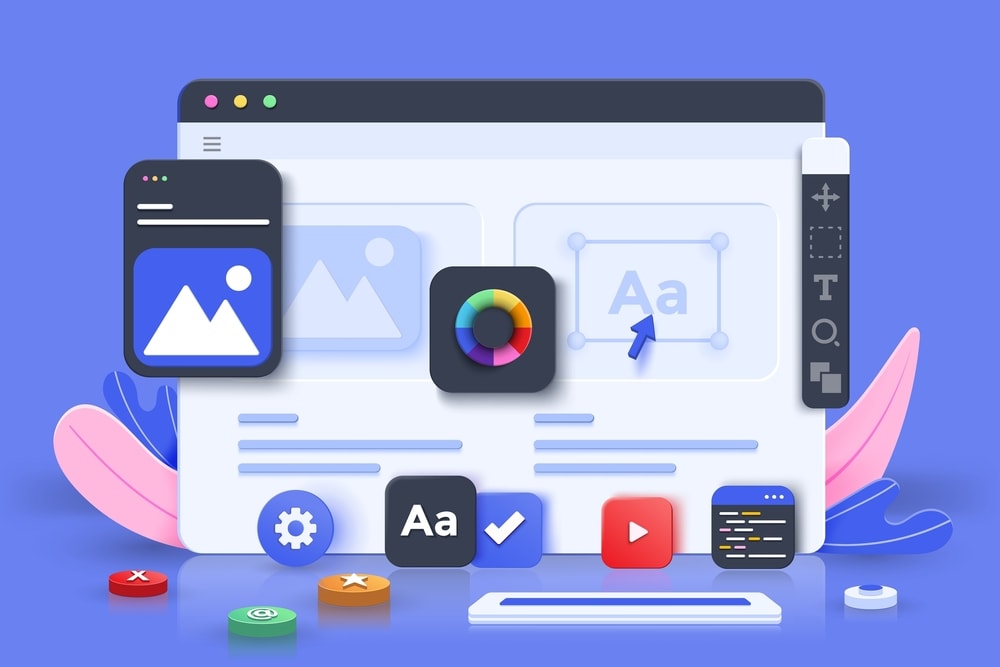Harnessing Digital Connections for Business Growth
Web applications enable business entities to connect with customers, improve organizational performance, and remain relevant in today’s dynamic digital economy. Modern enterprise web frameworks and native apps can provide more interactivity than conventional websites, and users can accomplish various operations within their browsers.
With the shift in focus of business operations to the Internet, the market complexity, scale, scope, and need for sound, reliable, flexible, and scalable enterprise web application development services have risen. Tech Craft Solution Development Services, a top app company, provides innovative web app development services to suit various business needs.
We have a comprehensive team of skilled developers with deep knowledge of modern web development frameworks, languages, and tools to help clients design and develop complex, fully responsive web applications that are secure and easily scalable to meet complex organizational, industry, technology, and end-user needs.
Whether you need to build a new web application from the ground up, migrate existing applications to the Tech Craft Solution platform, or add new functionality to an existing web show, Tech Craft Solution is your one-stop solution for cutting-edge, high-performance web solutions.
What is a Web Application?

A web application, or web app, is accessed through a web browser and runs on a network or web server rather than on a local computer or device. Users use web apps delivered through web browsers on smartphones, where they can interface with the app and manage the application and its features over the Internet.
Web Apps Vs. Websites
Websites are static, while web applications are dynamic, offering interactivity and usability. Websites and browsers are limited in functionality; they display information only in text, images, and videos. Web and browser apps allow users to input data, buy something, edit content, or play games. Some common examples of web applications include:
Some common examples of web applications include:
• Email Clients: Gmail, Outlook
• Social Media Platforms: Some of the SNSs include Facebook and Twitter.
• E-commerce Platforms: Amazon, eBay
• Productivity Tools: For instance, Google Docs and Trello.
• Online Banking: Such companies as PayPal and Stripe
Role of Web Apps for Businesses
For many businesses, these new modules, web portals, and mobile apps are an opportunity to deliver utility to customers through services. They may be used to increase customer interaction, optimize business processes, and gain valuable information. Web applications are essential for today’s business regardless of whether the app is directly connected with the customer or is used internally.
Web Application Development Procedure
A web application development platform or a web application developer app development process is a process that can be described in several stages, next steps, and phases through which an app should be built. Here’s how long it takes, and it takes a closer look at each stage of the web application developers, web developers’ app, or web API development process:
Consultation and Business Review
The app development process begins with a meeting between the development team and the client to establish contact, discuss the app’s details and features, determine the client’s requirements and expectations, and identify the target market. Business analysis is carried out to establish the nature of the business, the specific application, features, and functions of the app.
Planning and Strategy Development process
From the business analysis, the development team formulates a plan for project implementation. Some key activities include understanding the project’s objectives, business goals, and boundaries, scheduling the project activities, resource management, and planning the project deliverables or critical project phases. Another part of the strategy is choosing the correct technologies and other tools used for development.
Design and Prototyping
The design phase involves the project managers developing the app’s UI and UX. Designers then work on wireframes and models to plan how the app or web solution will look and function for high user satisfaction and speed. This stage is crucial for developing a web portal or app that is as user-friendly as possible and meets the client’s requirements.
Development (Front-End and Backend)

The development phase involves building and writing the code, and this saves time where programming and editing are mainly done. It is divided into two parts:
- Front-end development entails creating the app’s graphical user interface using HTML, CSS, and JavaScript technologies.
- Backend Development: This includes creating the application’s backend functionality and handling the databases and web services used in it.
- 5. Testing and Quality Assurance
- After the app is developed, the software is thoroughly tested to find flaws. This includes functional testing, usability testing, performance testing, and security testing. Quality assurance ensures the application is free from defects and safe to release.
Deployment and Maintenance
After testing, the app is put on a live server where users can use it. It is tested in a live environment on multiple platforms before being released. In the last phase of an entire cycle, a complete cycle, post-deployment automated testing, the development team is responsible for the constant maintenance and support of the application. Those who provide maintenance are general services that include updating the system frequently, applying security patches, and enhancing performance.
Technologies used in developing Web App
Web app development encompasses a broad spectrum of technologies, each of which is significant in the construction and operation of the application. Here’s an overview of some of the critical technologies used. Here’s a summary of some of the key technologies used:
Front-End Technologies
HTML (Hypertext Markup Language): The language used to build web pages on the World Wide Web.
CSS (Cascading Style Sheets): An XML-based language used to describe the formatting of a document written in HTML.
JavaScript: A language used to create web interfaces that allow users to interact with a web page.
React A JavaScript-based library for developing user interfaces, especially for Single-Page Applications.
Angular: A web application framework that is based on TypeScript.
Backend Technologies

Node.Js: A runtime environment that enables scripting on the server side using JavaScript.
Python: A high-level programming language used in Web development, Machine learning, data analysis, etc.
Ruby on Rails: A server-side web application framework implemented in Ruby.
PHP: A widespread general-purpose language tailored for web development.
Java: A computing language that is employed in the creation of significant and stable server-side applications.
Databases

SQL (Structured Query Language): A standard language used for managing the database and manipulating the same.
NoSQL: A type of database or technology that allows data storage and access that is not stored in tables as used in relational databases (for instance, MongoDB).
API Integration

APIs (Application Programming Interfaces) are how web applications interact with other services and systems. This is important for incorporating third-party services such as payment gateways, social media platforms, etc.
Cloud Services and Hosting
Web app hosts and cloud services such as AWS (Amazon Web Services), Google Cloud, and Microsoft Azure offer the integrated platform and infrastructure required to host, manage, and grow web applications. These services provide storage, computation, and communication and the means to deliver them for building and managing web app hosting infrastructure.
Types of Web Applications
Web applications are of different types and are used for other purposes and to fulfil other business requirements. Here are some of the most common types: Here are some of the most common types:
- Static Web Applications
- Dynamic Web Applications
- Single Page Applications (SPAs)
- Multi-Page Applications (MPAs)
- Progressive Web Apps (PWAs)
- E-commerce Web Applications
- Content Management Systems (CMS)
Static Web Applications
Static web apps are the easiest to build out of all types of web applications. They are constructed beforehand and do not alter users’ behaviors. These apps are fast and secure but less interactive than essential apps.
Dynamic Web Applications
Dynamic web apps are functional and change according to the user’s inputs. They employ server-side processing to create content dynamically and, therefore, are ideal for use in blogging, forums, and other e-commerce tools.
Single Page Applications (SPAs)
SPAs work on a server-side programming whole app or single HTML page and update specific sections when the user interacts with the server-side script, client-side script, or app. They are nonintrusive and provide a smooth and intuitive user experience, and they are used in many modern web applications, such as Gmail and Trello.
Multi-Page Applications (MPAs)
MPAs are conventional web applications in which every user action causes a new page to be loaded. This approach is appropriate for large applications with a lot of content, such as e-shops.
Progressive Web Apps (PWAs)
PWAs are a perfect blend of regular web pages and mobile applications.
They are web applications that run on mobile devices and have the capabilities of an app native-like mobile experience, such features as offline use, seamless navigation, and notification support.
E-commerce Web Applications
E-commerce web apps are meant for online shopping and app stores. Their functions include a product list, shopping cart, payment modules, inventory, and order processing systems.
Content Management Systems (CMS)
Web applications like WordPress, Joomla, and Drupal help users generate, edit, and deploy content without coding experience through CMS.
Advantages of Web App Development
Developing secure web applications and apps is precious for businesses for the following reasons. Here are some of the key advantages: Here are some of the key benefits:
1. Cross-device and cross-platform access
Web apps can be used from any device or platform with a web browser, making them easily accessible. They provide user profiles with one app on a single platform and a single look and feel for desktops, tablets, and smartphones so that users can constantly interact with the app.
2. Cost-Effective Development
Creating and maintaining a web application is usually cheaper than creating applications for specific desktop operating systems.
Web apps are also cross-platform, which means web app developers don’t need to develop different versions of the app for other operating systems on which the browser is available.
This reduces development time and costs.
3. Compatibility with Other Services
Web apps can also easily interface with other backend services and applications through API.
This seamless integration allows organizations and global brands to provide the user with the full range of benefits of a seamless, intuitive, and unified experience by integrating other backend services such as payment gateways, customer relationship management systems, and social media networks.
4. Enhanced User Experience and Engagement
Web portal apps are also very engaging and offer the convenience of the user a very dynamic and interactive environment to explore. Real-time updates, content filtering capabilities, and accessible web portal navigation help users stay updated and engaged. Hence, they are the back end and spend more time on the platform.
5. Security and Data Protection
Web applications can be designed with high levels of security to prevent data loss and meet regulatory requirements.
Encryption, secure authentication, and frequent updates for security purposes ensure client data protection.
6. Scalability and Flexibility
Web applications are easily scalable, especially with an increased user base and additional functionality. Cloud services and modern approaches to development enable businesses to grow their web apps vertically without many issues.
Choosing a Web App Development Company

Selecting the right web app development company is crucial to the success of your project. Here are some essential qualities to look for:
1.Experience and Expertise
Look for a company with a proven, reliable web and mobile app development track record. Check their portfolio and case studies to see if they have experience with projects similar in scale and scope to yours. Experienced developers and teams are likelier to deliver a high-quality product on time and within budget.
2.Customization and Flexibility
Your web and mobile web app development costs should be tailored to your needs. Choose a development company that offers customization and free consultation and will work closely with you to understand all your questions and requirements.
Flexibility in the web app development process is essential to accommodate changes and new features as your idea and project evolve.
3. Looking at Past Works and Client Feedback
4. Post-Development Support and Maintenance
5. Advanced Analytics and Data Processing technology are integrated into the company.
Speaking about automation and data-driven decisions as a business trend is now possible. Web apps incorporate increasingly sophisticated analytical and data analysis capabilities to gather, analyze, and represent data in real time.
This automation allows businesses to automate workflows, gain insights about users, enhance their performance, and get actionable insights to make better decisions.
Security monitoring techniques, compliance reporting, and monitoring practices are priorities for the organization and its internal business operations teams to implement and maintain.
Security is critical in the development of web applications, and this has become more paramount as threats to security vulnerabilities in the cyber world rise.
Software developers integrate the best security features, such as encryption, multi-factor authentication, and secure APIs, into their products to protect user data. Adherence to these legal provisions, regulations, and compliance standards is also becoming more crucial, especially for applications that deal with personal data, as observed in GDPR and HIPAA, among others.
Why hire tech craft solution for your web application solutions

We at Tech Craft Solution are committed to providing you with the best web applications that suit your business requirements. Our team of experienced developers aims to develop reliable, easy-to-use, and easily scalable solutions to help your business thrive. Our main values are open communication, punctuality, and cooperation at each workflow stage, so your project is safe with us. To get the best quality web applications that can transform the way your business functions, go for Tech Craft Solution.
Exploring the Tech Craft Solution Development Cycle
The web app development industry is one of the fastest-growing technology industries, and constantly developing technology spheres are essential for business growth and sustainable bottom-line performance. Web apps can enhance customer relations and sales, optimize processes by saving time, and generally enhance value in a company, which is why they are in such demand and an essential concept for start-ups and large enterprises now.
However, to create and launch a successful web app over a decade, enterprises must plan it, choose the right backend technologies, and engage and use the services of competent web app developers. Thus, awareness of the details of web APIs, of the whole web app development solutions and process, selection of the proper company, and knowledge of modern web frameworks and trends will allow businesses to develop robust web applications with faster loading time and sustainable performance that will help them grow.
This article will be helpful to business analysts, people, and professionals who want to invest resources in web applications and developers and professionals who wish to expand their knowledge, ideas, and skills in web applications.
What is a web application example?
Web applications include online forms, shopping carts, search engines, word processing systems, spreadsheets, video and photo editing tools, and email services like Yahoo and Gmail.
What are the three types of web applications?
Types of web applications—Example websites—Benefits and Challenges. Application statics. Dynamic web application. Application pages (SPAs). Web application for multiple pages (MPAs). Progressive Web Apps (PWA). Website content management systems (CMO). Websites for e-commerce. JavaScript Web Application Development.
What is a web application service?
Tell me the meaning of web apps on the Internet. Web applications are applications that operate on web browsers. Businesses can exchange data and provide services remotely. It uses Web applications to communicate efficiently and safely.
What is web application software and examples?
Tell me the meaning of web apps on the Internet. Web applications are applications that operate on web browsers. Businesses can exchange data and provide services remotely. It uses Web applications to communicate efficiently and safely.

2 Responses
Process is easily understood
Thank you for taking the time to share your thoughts. I’m happy the process was helpful.